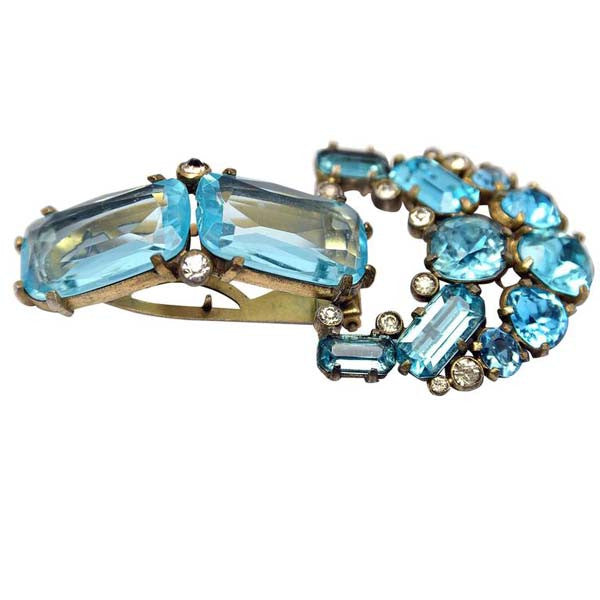1950s Hattie Carnegie Rhinestone Cross Brooch
Sold Out
Description
Gorgeous clear and bright rhinestone brooch by Hattie Carnegie. This brooch has a round, multifaceted center with four, curved, cross - like bars composed of emerald - cut rhinestones. The bottom layer of the brooch is composed of floral arrangements of marquise - cut rhinestones. Silver - tone base. Truly an elegant, dazzling, dimensional brooch.
Hattie Carnegie was born Henrietta Kanengeiser in Vienna, Austria-Hungary. She was the second of seven children, and lived in poverty in her youth. The family immigrated to the United States when she was still a child, and settled in Manhattan. After her father’s death in 1902, Hattie took a job as a messenger at Macy’s to help support her family, and in 1904 she modeled and trimmed hats at a millinery.
In 1909 Hattie branched out, launching a hat making business with dressmaker Rose Roth, but by 1919 Roth had left the business, leaving Carnegie as the owner of “Hattie Carnegie, Inc,” a company that had a working capital of $100,000. Carnegie began traveling to Paris to buy original dresses to both sell in her shop, and use as inspiration for her own garment and accessory designs. Carnegie was instrumental in bringing Paris fashion to the United States; she imported Lanvin, Molyneux, Patou, Schiaparelli, Vionnet, and others, lavishing New York with gorgeous garments and groundbreaking designers that would have not crossed the pond otherwise. Carnegie also discovered and nurtured the talents of many prominent American designers, including Norman Norell, Pauline Trigère, and James Galanos. In 1925, Carnegie bought a building off of Park Avenue to house her $3.5-million-a-year business, and stayed there producing pieces throughout the Great Depression.
During World War II French haute couture came to a standstill. Carnegie rose to prominence on the international stage as an authority on fashion, and her works were seen in the theatre, cinema and on magazine covers. Although still glamorous, her designs became more austere when the United States joined the Allied Powers. As a part of the war effort, Carnegie designed a dress for Life Magazine. The dress patterns were published in the magazine alongside detailed instructions; it was said that although the dress could have been made for as little as $5, the original dress was valued at $175. After the war, Carnegie continued her business, the epitome of perseverance. Sometime in her early 20s, Hattie had taken the last name Carnegie after Andrew Carnegie, the industrialist, philanthropist, and richest man in the United States during her lifetime. She certainly lived up to the name, having worked her way through and out of an impoverished childhood and into a glamorous life doing what she loved, while still grossing millions a year.
Carnegie passed away in 1956, having been instrumental in the diffusion of Parisian fashion into American society, having nurtured the finest designing minds of the early and mid 20th century, and having designed all manner of enchanting things, including hats, handbags, gloves, jewelry, furs, lingerie, cosmetics, and even perfume.
-
Country of OriginUnited States
-
ConditionExcellent
-
Materials & TechniquesCrystal
-
Size
Related Items
1930s Eisenberg Original Aquamarine Rhinestone Fur Clip
$445.00
Absolutely amazing Pre-WWII Eisenberg Original aquamarine rhinestone fur clip. Vintage jewelry collectors agree that there weren't many Jewelers in United States history quite like Eisenberg. Attention to detail, use of fabulous materials, and creativity allowed Eisenberg jewelry to withstand the test of time. Their pieces show the progression of the US and the aspirations of a growing middle class. American woman, while not royalty, could dress and feel like royalty in an Eisenberg Original. The brooch is versatile: use it as a purse clasp, a lapel brooch, a pendant, even a hat pin if you like! The piece is beautiful enough on its own, and would not look amiss on a vanity. Makes a wonderful gift for a loved one or for yourself.
1940s Eisenberg Original Rhinestone Floral Brass Bouquet Fur Clip
Sold Out
Beautiful rhinestone and faux pearl fur clip by Eisenberg. The four blooming flowers and two buds sprout from an antique brass stem. The flowers have emerald cut orange rhinestone centers, each sporting five grey pearl petals. Small round multifaceted white rhinestones decorate the receptacle of the flowers. The "bouquet" features gracefully placed pale yellow rectangular rhinestones, and orange pear and round cut rhinestones. Signed "Eisenberg Original" on reverse.
Eisenberg was founded in 1918 by Jonas Eisenberg, an Austrian Immigrant who had moved to Chicago in 1885. The Eisenberg company initially sold ready-to-wear Womens clothing, but the company had such success with the jewelry they created to go on the garments, that they began designing and manufacturing jewelry as well. In 1958, Eisenberg ceased manufacturing garments, and from then on focused solely on jewelry. During the 1960s and 1970s, Eisenberg partnered with artists, including Picasso, Miro, and Calder. Eisenberg created the creme de la creme of mid century rhinestone jewelry, their pieces often cost more than the average woman’s weekly salary, causing Eisenberg jewelry to be rather rare.
1940s Eisenberg Original Sterling Rhinestone Bouquet Brooch
Sold Out



